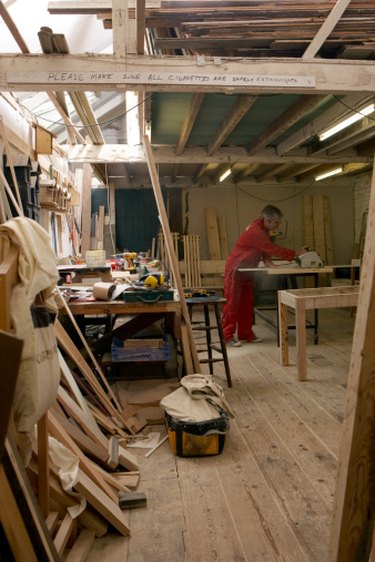Things You'll Need
Measuring tape
Pencil
Large carpenter's square
Masking tape
Straightedge clamp
Circular saw
Carbide-tipped, cross-cutting, 40-tooth saw blade

Butcher block counter tops lend a warm ambiance to the kitchen. Unlike laminate and tile counter tops, butcher block is easy to saw and shape into unusual angles or rounded corners. Most wood counter tops are constructed of maple hardwood -- a prized wood known for it's fine grain and rock-solid stiffness. When cutting butcher block counters, use the sharpest saw blade in the toolbox. Masking tape along the cutting line prevents jagged tears from marring the smooth surface of the wood.
Step 1
Measure carefully the width of the run of cabinets to be covered with butcher block. If the end of the run is open ended and not between two walls, allow a 1-inch overhang of butcher block for the end of the counter top.
Video of the Day
Step 2
Place the butcher block on a secure surface. Measure out the distance of the run of cabinets, including the 1-inch overhang, if applicable. Draw the line boldly with the pencil, using the carpenter's square to draw a perfectly straight line.
Step 3
Place two layers of masking tape over your pencil line. If you cannot see your pencil line below the layers, make the line bolder and more visible. Press the masking tape firmly.
Step 4
Adjust the height of the saw blade in the saw using the small wing nut that raises or lowers the saw's guide plate. The blade should hang about 1/4 inch below the bottom of the butcher block counter top. A blade that hangs too low beyond the thickness of the wood may pull at the wood fibers, causing tears and splintering.
Step 5
Attach the straightedge clamp along your pencil line. The straightedge guides your circular saw, enabling you to cut a perfectly straight line across the counter top. Adjust your straightedge clamp so that the circular saw blade guide plate will run along the clamp and the saw blade will run along the pencil line. Circular saw designs vary greatly, so you need to adjust and check the positions of both the guide plate and the blade several times. Take your time to make sure your clamp is in the correct position, as this is the most important step for making a straight, clean cut.
Step 6
Saw the butcher block along the pencil line. Move the circular saw at an even pace, but not so fast that the blade tears the wood.
Step 7
Enlist a helper to catch the extra section of butcher block counter top as you near the end of the cutting run, to avoid tearing or splintering your good section.
Tip
You may notice gaps between the butcher block counter and the walls if your walls are bowed or not plumb. To cover these gaps, install a wood backsplash using 1-inch-by-4-inch maple wood boards. Glue or nail the backsplash to the studs in the wall. Caulk the seam between the backsplash and the butcher block counter top with clear caulk.
Butcher block manufacturers create their counter tops to be 24 inches wide -- the standard width for all kitchen counters. Therefore, you do not need to cut the butcher block lengthwise.
Warning
Before installing the counter top, seal the cut edges of the butcher block with a water-based polyurethane finish. The finish prevents humidity and moisture from seeping into the grain and warping the wood.
Use a brand new carbide saw blade. Dull or older blades will move too slowly, and may burn the wood or cause jagged tears.
Video of the Day